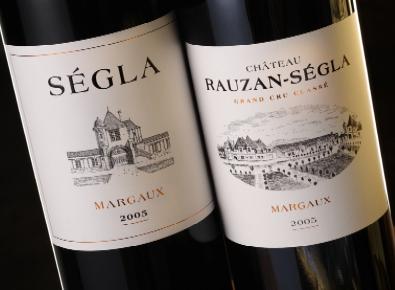|
 
|
|
Chateau Rauzan - Segla
|
Location:
Chateau Rauzan-Segla is in the commune of Margaux.
Margaux is located in the Medoc
on the left bank of the Gironde
Estuary in Bordeaux.
|
Size:
. There are 52 hectares under vines (128 acres). There are plans to slightly increase to 54 or 55 hectares by about 2010. Production
is 8,000 cases per year of Chateau Rauzan-Segla out of a total
estate production of about 15,000 cases of total wine.
|
Classification:
Second
Growth in the Medoc Classification of 1855.
|
Vineyard:
54% Cabernet
Sauvignon, 40% Merlot, 5% Cabernet
Franc, 1% Petit
Verdot The average age of the vines is about 30 years. The soil is a mixture of fine gravel and clay. The
vines are planted to a density of 6,600 to 10,000 vines per
hectare (2,670 to 4,050 per acre) depending on the variety and
vineyard section. During the growing season, Chateau Rauzan-Segla
regularly thins the foliage to allow better ripening of the
fruit and also performs green harvesting. Green harvesting
is a practice of going through the vineyards and cutting off
some of the fruit clusters where there are too many present
for the vine to bring them all to maturity.
|
Vinification:
The grapes are harvested by hand as the law requires in Bordeaux. The grapes then go through a selection process on double sorting tables. This additional step is done to ensure that the grapes in the wine are of the highest level of quality. Fermentation and maceration take place in temperature controlled
stainless steel tanks and last about 3 weeks depending on
the vintage. During the period of fermentation, the wines
in the tank are pumped over the cap (skins and grape pulp
that have floated to the top of the tank) twice per day.
The
wines are placed in oak
barrels for 18 months of aging after fermentation.
50% to 60% of the barrels are replaced each year. The percentage
of new barrels can vary slightly as the winemaker determines
the amount of oak influence that is best for the particular
vintage. The oak used by Chateau Rauzan-Segla comes from the
Troncais forests of France. During the aging period, the wines
are racked every 3 months to removes sediments. Once barrel
aging is complete, the wines are fined with egg whites in
the traditional manner before bottling.
|
History:
The chateau takes its name from Pierre des Mesures de
Rauzan who purchased it in 1661 and developed it into vineyards.
The chateau remained in the family and maintained an excellent
reputation until it was ravaged by phyloxera (as was all of
Bordeaux) in the 1860s. It was accorded Second Growth status
in the 1855
Classification of the Medoc. In the original distribution
of the 1855 Classification, Chateau Rauzan-Segla was listed
6th, just behind the four First Growths and Chateau
Mouton Rothschild.
Frederic
Cruse, a very successful negociant, purchased Rauzan-Segla
in 1903. He invested heavily and made many improvements. He
is responsible for the building of the house and for the complete
replanting of the vineyards and renovation of the facilities.
The vineyards had never fully recovered from the damage caused
by pholloxera until Cruse took ownership. During the period
between 1957 when the Cruse family sold the chateau and the
early 1980s, Chateau Rauzan-Segla was an underachiever and
had several owners.
Since
1983, it has resumed its position as a premier producer and
worthy of its rank. That was due to the involvement from that
year by Jacques Theo who became involved with the chateau's
operations and wine making. He brought in a new cellar master,
built a new wine making facility (chai), and also made adjustments
in all aspects of the wine production from vineyard, grape
selection and barrel selection. Rauzan-Segla is owned by Château
Rauzan-Ségla S.A. which is a subsidiary of the Chanel
Group. This ownership change took place in 1994. This ownership
has once again invested in the property and is keeping it
in top shape.
The
General Manager of Chateau Rauzan-Segla is John Kolasa. The
winemaker is Henry de Ruffray and the vineyard manager is
Jean-Claude Loubère.
|
Style:
Chateau Rauzan-Segla makes wine that is big, multi layered
and multidimensional. The wines often seem brawny and disconnected
when very young but come together nicely with age. Violets,
blackberry, cherry and cedar can be found in the nose and
taste of the younger wines. As the wine ages, cassis and spicy
overtones appear. These wines are very long lived and are
usually at their best from 10 to 25 years after the vintage
date if properly stored. The best vintages can last decades
longer.
|
Food:
Serve with full flavored foods when the wine is younger.
Cuts of beef that are individually grilled and left a bit
rarer than normal are a perfect choice if the wine is less
than 15 years old. If the wine is more mature, serve it with
lamb or beef that is cooked as a roast and not in individual
servings. If serving beef, make it less rare than with a younger
wine.
|
Second
Wine: Segla
|
Visits
and Tours: Visitation to Chateau Rauzan-Segla is by appointment
only. Tours can be arranged by contacting the Chateau via e-mail at (contact@rauzan-segla.com).
Tours can be made Monday through Friday from 9:00 am to Noon
and from 2:00 pm to 5:00 pm. The tours can be in French, English or Spanish.
|
This
information was updated in March of 2008 with the assistance
of Sandrine Begaud. She is the public relations manager of Chateau
Rauzan-Segla. We greatly appreciate her help.
|
|
B.P. 56 - 33460
MARGAUX - FRANCE
Tel. : +33 (0) 557 88 82 10 - Fax : +33 (0) 557 88 34 54
|

